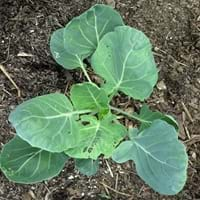Life Span
Perennial
Biennial
Type
Bulb or Corm or Tuber
Vegetable
Origin
Hybrid origin
Southern Europe, Western Europe, Mediterranean
Types
Not Available
Wild cabbage, Cabbage, Savoy cabbage
Number of Varieties
Not Available
Habitat
tropical environments
Fertile bottom land, Moist Soils, Well Drained
USDA Hardiness Zone
8-11
4-8
AHS Heat Zone
Not Available
6-1
Sunset Zone
21,22
A1, A2, A3, H1, H2, 1a, 1b, 2a, 2b, 3a, 3b, 4, 5, 6, 7, 8, 9, 10, 11, 12, 13, 14, 15, 16, 17, 18, 19, 20, 21, 22, 23, 24
Habit
Clump-Forming
Upright/Erect
Flower Color
White, Red, Light Pink
Yellow
Flower Color Modifier
Bicolor
Bicolor
Fruit Color
Green, Brown
Not Available
Leaf Color in Spring
Green, Dark Green
Not Available
Leaf Color in Summer
Light Green
Green
Leaf Color in Fall
Several shades of Green
Green
Leaf Color in Winter
Light Green
Green
Leaf Shape
Long Linear
Broad, Unlobed
Plant Season
Spring, Summer, Winter
Spring, Summer, Fall, Winter
Sunlight
Full Sun, Partial Sun
Full Sun, Partial Sun
Type of Soil
Loam, Sand
Loam, Sand
The pH of Soil
Acidic, Neutral
Neutral
Soil Drainage
Well drained
Well drained
Bloom Time
Not Available
Late Spring, Early Summer, Summer
Tolerances
Deer resistant
Drought
Where to Plant?
Container, Ground, Pot
Container, Ground
How to Plant?
Divison, From Rhizomes, Tubers
Seedlings, Transplanting
Plant Maintenance
Low
Medium
Watering Requirements
Average Water Needs
Average Water Needs, Keep ground moist, Needs a lot of water initially, Needs watering once a week, Never Over-water
In Summer
Lots of watering
Lots of watering
In Spring
Moderate
Moderate
In Winter
Average Water
Average Water
Soil pH
Acidic, Neutral
Neutral
Soil Type
Loam, Sand
Loam, Sand
Soil Drainage Capacity
Well drained
Well drained
Sun Exposure
Full Sun, Partial Sun
Full Sun, Partial Sun
Pruning
Cut or pinch the stems, Remove damaged leaves, Remove dead branches, Remove dead leaves
Prune lower leaves, Remove damaged leaves, Remove dead branches, Remove dead leaves
Fertilizers
as it is a flowering plant, use high phosphorous content fertilizer, Nitrogen, Phosphorous, Potassium, Requires high amount of nitrogen
5-10-10 fertilizer, All-Purpose Liquid Fertilizer, Apply 10-10-10 amount
Pests and Diseases
Aphids, Grasshoppers, Mealybugs, Mites, Red blotch, Slugs, Snails
Red blotch
Plant Tolerance
Deer resistant
Drought
Flower Petal Number
Not Available
Single
Edible Fruit
Not Available
No
Fragrant Flower
Not Available
No
Fragrant Bark/Stem
No
Yes
Foliage Texture
Medium
Bold
Foliage Sheen
Glossy
Matte
Attracts
Bees, Butterflies, Hummingbirds
Insects
Allergy
poisonous if ingested
allergic reaction, breathing problems, Dizziness, Headache, Itchiness, Low blood pressure, Runny nose, Skin rash, Stomach pain, Swelling
Aesthetic Uses
Beautification, Bouquets, Cottage Garden, Showy Purposes
Not Used For Aesthetic Purpose
Beauty Benefits
Not Available
Good for skin
Environmental Uses
Not Available
Air purification
Medicinal Uses
Not Available
anti-inflammatory, Anti-oxidant, Cardiovascular problems, cholesterol-lowering, Detoxification, Fiber, Minerals, Nutrients, Vitamin C
Part of Plant Used
Flowers
Fruits
Other Uses
Used as Ornamental plant, Used for bedding in gardens
Not Available
Used As Indoor Plant
Yes
Insignificant
Used As Outdoor Plant
Yes
Yes
Garden Design
Container, Cutflower, Houseplant, Mixed Border, Tropical
Edible, Herb / Vegetable
Botanical Name
HIPPEASTRUM 'Picotee'
BRASSICA oleracea 'Diablo'( Gemmifera Group)
Common Name
Florist Amaryllis, Hippeastrum, Picotee Hippeastrum
Brussels Sprouts
In Hindi
HIPPEASTRUM
Brussels Sprouts plant
In German
HIPPEASTRUM
Rosenkohl Pflanze
In French
HIPPEASTRUM
Choux de Bruxelles plante
In Spanish
Hippeastrum
planta de coles de Bruselas
In Greek
Hippeastrum
φυτό Λαχανάκια Βρυξελλών
In Portuguese
HIPPEASTRUM
Couves de Bruxelas planta
In Polish
Hippeastrum
Brukselka roślin
In Latin
Hippeastrum
Bruxellis pullulat herba
Phylum
Magnoliophyta
Magnoliophyta
Class
Magnoliopsida
Magnoliopsida
Order
Asparagales
Capparales
Family
Amaryllidaceae
Brassicaceae
Clade
Angiosperms, Monocots
Angiosperms, Eudicots, Rosids
Tribe
Not Available
Not Available
Subfamily
Amaryllidoideae
Not Available
Number of Species
Not Available
Season and Care of Hippeastrum and Brussels Sprouts
Season and care of Hippeastrum and Brussels Sprouts is important to know. While considering everything about Hippeastrum and Brussels Sprouts Care, growing season is an essential factor. Hippeastrum season is Spring, Summer and Winter and Brussels Sprouts season is Spring, Summer and Winter. The type of soil for Hippeastrum is Loam, Sand and for Brussels Sprouts is Loam, Sand while the PH of soil for Hippeastrum is Acidic, Neutral and for Brussels Sprouts is Neutral.
Hippeastrum and Brussels Sprouts Physical Information
Hippeastrum and Brussels Sprouts physical information is very important for comparison. Hippeastrum height is 38.10 cm and width 30.10 cm whereas Brussels Sprouts height is 121.92 cm and width 60.96 cm. The color specification of Hippeastrum and Brussels Sprouts are as follows:
Hippeastrum flower color: White, Red and Light Pink
Hippeastrum leaf color: Green and Dark Green
Brussels Sprouts flower color: Yellow
- Brussels Sprouts leaf color: Not Available
Care of Hippeastrum and Brussels Sprouts
Care of Hippeastrum and Brussels Sprouts include pruning, fertilizers, watering etc. Hippeastrum pruning is done Cut or pinch the stems, Remove damaged leaves, Remove dead branches and Remove dead leaves and Brussels Sprouts pruning is done Prune lower leaves, Remove damaged leaves, Remove dead branches and Remove dead leaves. In summer Hippeastrum needs Lots of watering and in winter, it needs Average Water. Whereas, in summer Brussels Sprouts needs Lots of watering and in winter, it needs Average Water.





